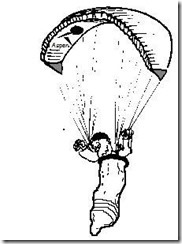Radios – who needs ‘em? Distracting chatter, something else to go wrong etc. Well, there I was focused on tagging cylinder 9 and getting low. Since it was a busy day, I thought all I had to do was look around to find someone going up, and go to them…. Where is everyone? Then I saw the red helicopter approaching the hill from beyond the glider club. My first thought was ‘why did no-one radio’? The realised the wire dangling from my headset wasn’t actually connected to anything. So, 2 black marks for the safety officer: 1. Not completing my pre-flight check (Radio connected and checked is No 6 on my list) and 2. Not having a functioning radio when it could have been critical to clear the air. Fortunately, no harm done as I was as far away from the helimed’s approach path as possible on the day, but it could have been very different if the medics had been unable to land.
The incident itself raised a couple of issues. The walking party called 999 but there seems to have been some confusion about their location and some delay before one of our pilots was able to talk on the phone to the operator and give a precise location. This emphasises the need for someone to take charge at an incident and direct the flow of information to a delegated person capable of communicating with the relevant services. We will be putting on a First Aid course over the winter (social distancing rules permitting) and one of the key elements of this will be organising an incident scene.
The current restrictions seem to have coincided with a rash of new faces on our sites. Many of these are seasoned pilots who can no longer travel as far as they used to to fly, but some are relative beginners and unfamiliar with busy sites. Be aware that some of these may hold no pilot qualifications or third-party insurance. Such individuals are a perennial issue, and we hope that all our members can do their bit by persuading them that the benefits of joining BHPA and PSC are worth the modest cost. On the day of the incident there were maybe 50 gliders in the air at times, and there were plenty of examples of downwind slope landings, blow-backs over the bowl and careless turning. It’s in all of our interests to do our best to ensure that everyone with whom we share the air has at least CP-level of competence.
On strong days on Parlick, it’s common for PG pilots to launch below the top, sometimes well below the wall. Please remember that HG pilots will still be launching from the top or possibly over-shooting a failed top landing. A conflict between a HG and a PG popping up vertically in their path doesn’t bear thinking about. Part of everyone’s launch routine should be a good look around to ensure that the air is clear. This applies to both PG and HG pilots – we don’t have launch marshals, so it becomes a personal responsibility to make sure you are taking off into clear air without threat of conflict with another aircraft.
A member reported getting bitten above the ankle on Tailbridge, which resulted in very painful swelling and immobility for some days. Be aware that ticks lurk in the grass waiting for some tasty flesh to pass by, and ticks can carry some pretty horrific diseases including Lyme disease, babeiosis and tick-borne encephalitis. Keep your legs covered, check yourself over for ticks at the end of the day, and report to a doctor if you feel unwell after getting bitten.
Tight lines
Brian
